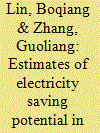| Srl | Item |
| 1 |
ID:
124437


|
|
|
|
|
| Publication |
2013.
|
| Summary/Abstract |
The paper analyzes the electricity saving potential of nonferrous metals industry in China. The cointegration method is applied to estimate electricity intensity of Chinese nonferrous metals industry, in an effort to predict future electricity saving potential. The results show that there is a long-run equilibrium between electricity intensity and factors such as R&D intensity, industrial electricity price, enterprise scale, and labor productivity. By means of scenario analysis, we evaluate different possible measures that might be adopted to narrow down the electricity efficiency gap between nonferrous metals industry in China and that of Japan. The results indicate that more active electricity conservation policies are needed in order to reduce the electricity intensity of Chinese nonferrous metals industry. We also find that the electricity efficiency gap could be significantly narrowed by 2020 if proper electricity conservation policy is adopted. Finally, based on the results of the scenario analysis, future policy priorities are suggested.
|
|
|
|
|
|
|
|
|
|
|
|
|
|
|
|
| 2 |
ID:
168303


|
|
|
|
|
| Summary/Abstract |
As electricity consumption in Vietnam has continued to increase much faster than has GDP, electricity intensity (EI) in the country has risen to levels far exceeding those of other Asia-Pacific economies (APEs). By analyzing evidence from a comparative study of other APEs through using the World Bank data, this study proves that EI in Vietnam is excessive and that its escalation over the last few decades cannot be justified as being due to supporting the country's policy of high economic growth. Factor analysis of the economic and electricity indicators for 22 APEs was used to track the shortcomings of the economic structure leading to the EI escalation in Vietnam. Electricity tariff, service share of GDP, and level of institution were identified as determinants of EI across the region. Given the weak performance regarding these indicators, Vietnam has highest EI among APEs followed by China and Mongolia. To reduce EI, Vietnam should consider diversifying away from the electricity-intensive industry sector toward economic activities such as service and information technology. The economic reform should be accelerated to complete the competitive electricity market and reduce the inefficiency of electricity usage through poorly managed state-owned enterprises and inefficient public investment projects.
|
|
|
|
|
|
|
|
|
|
|
|
|
|
|
|